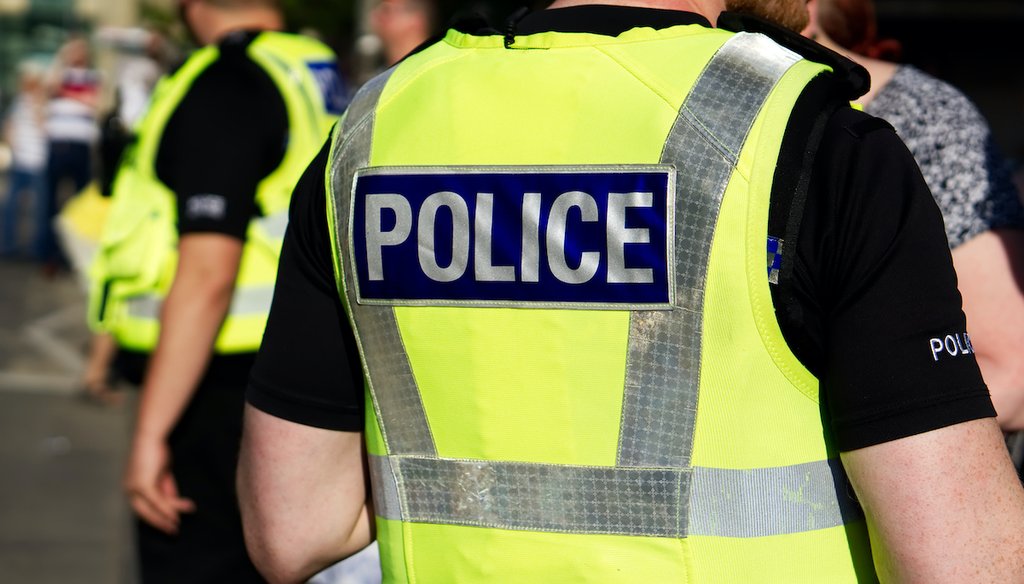

Our only agenda is to publish the truth so you can be an informed participant in democracy.
We need your help.


While those employed in law enforcement are often exposed to trauma, there is no indication from available data that police officers have the highest rates of suicide. (Shutterstock)
Data is limited, but what is available does not indicate police officers have the highest rate of suicide out of all professions or industries.
Women employed in protective services — a category that includes police officers, prison guards, firefighters and others — did have the fifth highest rate of suicide, according to the CDC’s most recent figures. Men in that category did not.
A Facebook user defending law enforcement officers claims that police officer is "the occupation with the highest suicide rate of any profession."
The post came amid the backlash to the Minneapolis police killing of George Floyd on May 25.
The post was flagged as part of Facebook’s efforts to combat false news and misinformation on its News Feed. (Read more about our partnership with Facebook.)
An annual study by the Centers for Disease Control and Prevention shows that five industries and six occupational groups had significantly higher suicide rates than than the overal population.
Police officers don’t register on the study when it is examined by industry. When the data is divided up by "occupational group," women involved in "protective services" were shown to have the fifth highest rate of suicide compared with the overall population. That group includes police officers, but it also includes prison guards, firefighters and others.
The latest study was produced in January 2020 and is based on data from 2016. Data from 32 states that participate in the National Violent Death Reporting System were used to calculate suicide rates.
Five major industry groups had significantly higher suicide rates than did the overall study population:
Mining, quarrying, and oil and gas extraction (men)
Construction (men)
Other services (e.g., automotive repair) (men)
Agriculture, forestry, fishing, and hunting (men)
Transportation and warehousing (men and women)
Six major occupational groups had significantly higher suicide rates than did the overall study population:
Construction and extraction (men and women)
Installation, maintenance, and repair (men)
Arts, design, entertainment, sports, and media (men)
Transportation and material moving (men and women)
Protective service, which includes police officers, prison guards, firefighters and others. (women)
Health care support (women)
The suicide rate for women in protective service occupations was 14.0 per 100,000 working population, higher than the rate among females in all occupations (7.7).
The suicide rate for women in protective service occupations was 14.0 per 100,000 working population, higher than the rate among females in all occupations (7.7).
But the suicide rate for men in protective service occupations was 26.4 per 100,000 working population, lower than the rate among men in all occupations (27.4).
Overall, the study determined that suicide risk is associated with "low-skilled work, lower education, lower absolute and relative socioeconomic status, work-related access to lethal means, and job stress, including poor supervisory and colleague support, low job control and job insecurity."
A nonprofit called Blue HELP tracks police officer suicides via internet searching and other means. According to Blue HELP, while police officer is not the occupation with the highest suicide rate, its unofficial figures show a somewhat highter rate than the CDC report, although for a different time period.
There are indications of an increase, Steven Hough, a co-founder of the group, told PolitiFact.
There have been 787 officer suicides since 2016, according to Blue HELP. For 2019, the group calculated the officer suicide rate at 22.4 per 100,000 population. That’s higher than the average rate among all occupations in the CDC study, but the CDC’s figures are for 2016. The group has counted 10 officer suicides since June 8, Hough said June 22.
There is no official central repository for information about how many suicides take place among law enforcement officers and under what circumstances, according to the Police Executive Research Forum and other research groups.
The forum says research shows that factors affecting suicide by officers include exposure to trauma, alcohol use, availability of firearms and the strains of shift work; and that post-traumatic stress disorder among police officers is five times more prevalent than in the general population.
A February 2020 report National Officer Safety Initiatives, said suicide risk factors specific to law enforcement officers include exposure to suicide and other traumatic events, easy access to firearms and skills in their use, and organizational stressors such as shift work.
A Facebook post claims police officer is "the occupation with the highest suicide rate of any profession." Data is limited, but what is available does not indicate police officer is at the top. We rate the post False.
Facebook, post (archived here), June 17, 2020
U.S. Centers for Disease Control and Prevention, "Suicide Rates by Industry and Occupation — National Violent Death Reporting System, 32 States, 2016," and Supplementary Table 2, Jan. 24, 2020
Email, Carol Runyan, director of the Program for Injury Prevention, Education and Research at the University of Colorado at Denver, June 20, 2020
Email, Steve Hough, co-founder of Blue HELP, June 22, 2020
Email, U.S. Centers for Disease Control and Prevention economist and suicide researcher Cora Peterson, June 22, 2020
BlueHELP.org, accessed June 22, 2020
National Officer Safety Initiatives, "Preventing Suicide Among Law Enforcement Officers: An Issue Brief," February 2020
Email, Ellyson Stout, director of the Suicide Prevention Resource Center at the Education Development Center, June 23, 2020
Email, Alexis O’Brien, spokesperson, American Foundation for Suicide Prevention, June 22, 2020
Email, Chuck Wexler, executive director of the Police Executive Research Forum, June 20, 2020
Police Executive Research Forum, "An Occupational Risk: What Every Police Agency Should Do To Prevent Suicide Among Its Officers," October 2019
In a world of wild talk and fake news, help us stand up for the facts.
